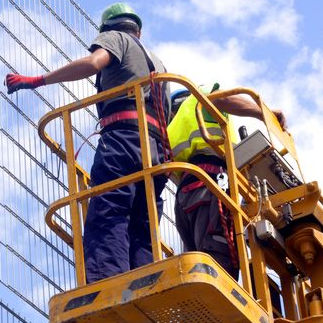Aerial Lifts
An aerial lift is any vehicle-mounted device used to elevate personnel. Types include:
- Extendable boom platforms,
- Aerial ladders,
- Articulating (jointed) boom platforms,
- Vertical towers, and
- Any combination of the above.
Aerial lifts have replaced ladders and scaffolding on many job sites due to their mobility and flexibility. They may be made of metal, fiberglass reinforced plastic, or other materials. They may be powered or manually operated, and are considered to be aerial lifts whether or not they can rotate around a primarily vertical axis.
Many workers are injured or killed on aerial lifts each year. OSHA provides the following information to help employers and workers recognize and avoid safety hazards they may encounter when they use aerial lifts.
Inspecting the Lift
When inspecting aerial lifts, check the following pre-start, vehicle, lift, and guardrail system items:
Pre-start Inspection
Prior to each work shift, conduct a pre-start inspection to verify that the equipment and all its components are in safe operating condition. Follow the manufacturer’s recommendations and include a check of:
Vehicle components
- proper fluid levels (oil, hydraulic, fuel and coolant);
- leaks of fluids;
- wheels and tires;
- battery and charger;
- lower-level controls;
- horn, gauges, lights and backup alarms; and
- steering and brakes.
Lift components
- operating and emergency controls;
- personal protective devices;
- hydraulic, air, pneumatic, fuel and electrical systems;
- fiberglass and other insulating components;
- missing or unreadable placards, warnings, or operational, instructional and control markings;
- mechanical fasteners and locking pins;
- cable and wiring harnesses;
- outriggers, stabilizers and other structures; and
- loose or missing parts;
Guardrail systems
- Do not operate any aerial lift if any of these components are defective until it is repaired by a qualified person.
- Remove defective aerial lifts from service (tag out) until repairs are made.
Work Area Inspections
Employers must assure that work areas are inspected for hazards and take corrective actions to eliminate such hazards before and during operation of an aerial lift. Items to look for include:
- drop-offs, holes, or unstable surfaces such as loose dirt;
- inadequate ceiling heights;
- slopes, ditches, or bumps;
- debris and floor obstructions;
- overhead electric power lines and communication cables;
- other overhead obstructions;
- other hazardous locations and atmospheres;
- high wind and other severe weather conditions, such as ice; and
- the presence of others in close proximity to the work.
Only trained and authorized persons are allowed to operate an aerial lift. The following training is required to ensure that aerial lifts are safely used:
- Explanations of electrical, fall, struck-by and falling object hazards;
- Procedures for dealing with hazards;
- Recognizing and avoiding unsafe conditions in the work setting;
- Instructions for correct operation of the lift (including maximum intended load and load capacity);
- Demonstrations of the skills and knowledge needed to operate an aerial lift before operating it on the job;
- When and how to perform inspections; and
- Manufacturer’s requirements.
Workers should be retrained if any of the following conditions occur:
- An incident occurs during aerial lift use,
- Workplace hazards involving an aerial lift are discovered, or
- A different type of aerial lift is used.
- Employers should also retrain workers who they observe operating an aerial lift improperly.
Knowledge Check Choose the best answer for the question.
3-8. Which vehicle-mounted device has replaced ladders and scaffolding on many job sites due to their mobility and flexibility?
You forgot to answer the question!

